Healthcare Case Study: Incident Reporting, Response, and Improvement
VerifiedAdded on 2023/04/24
|5
|976
|134
Case Study
AI Summary
This case study examines incident reporting within a healthcare organization, identifying key barriers such as fear of reprisal, concerns over anonymity, and lack of clear understanding of what constitutes a reportable incident. It highlights the critical role of leadership support in fostering a culture of safety and continuous improvement. The study analyzes the organization's current incident response procedures, evaluating their effectiveness and recommending improvements such as enhanced workflow, leadership accountability, and measures to eliminate fear of reprisal. Regular investigations and ongoing assessment are crucial to ensure the long-term success of these improvements. The ultimate goal is to enhance patient safety by preventing future incidents through systematic analysis and proactive measures. Desklib provides access to this and many other solved assignments.
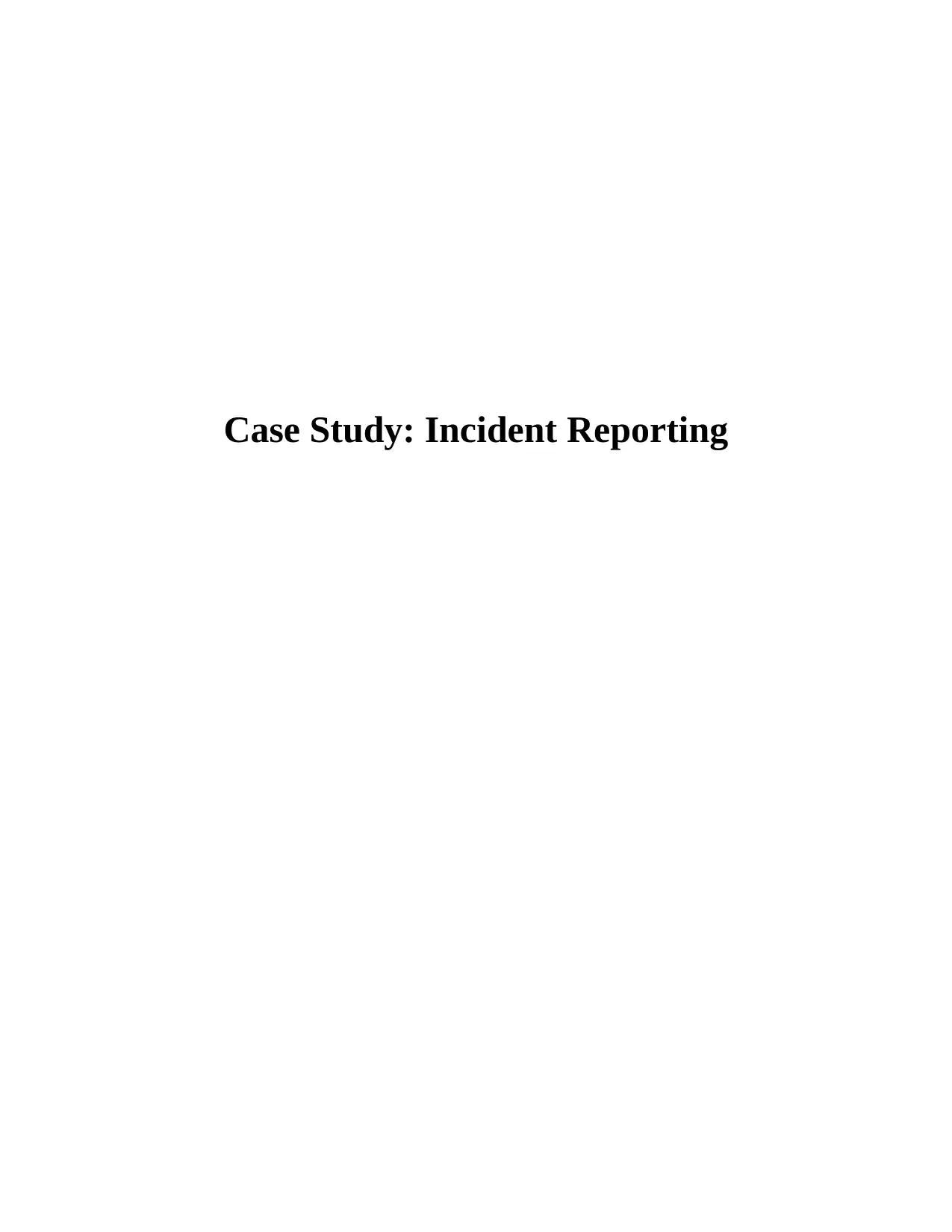
Case Study: Incident Reporting
Paraphrase This Document
Need a fresh take? Get an instant paraphrase of this document with our AI Paraphraser
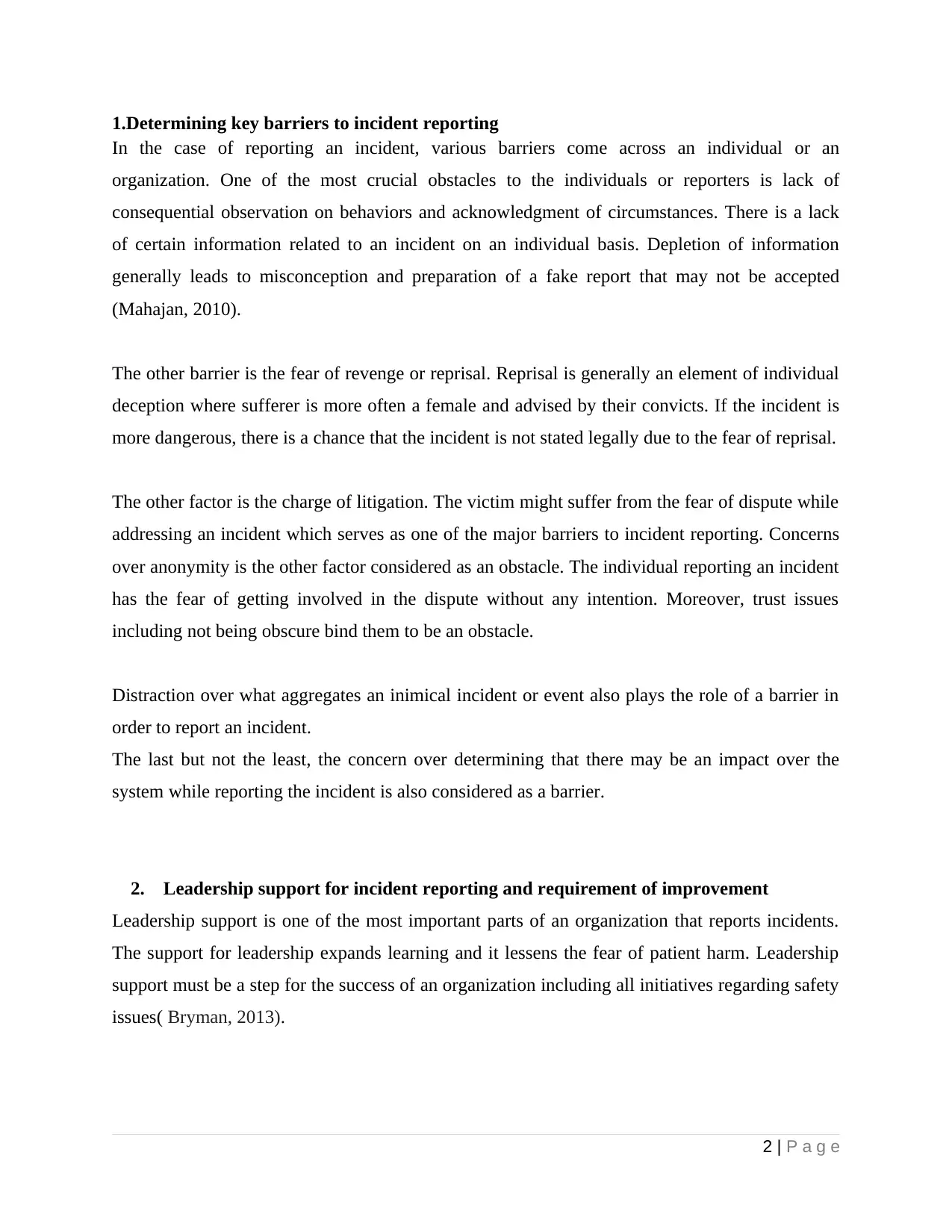
1.Determining key barriers to incident reporting
In the case of reporting an incident, various barriers come across an individual or an
organization. One of the most crucial obstacles to the individuals or reporters is lack of
consequential observation on behaviors and acknowledgment of circumstances. There is a lack
of certain information related to an incident on an individual basis. Depletion of information
generally leads to misconception and preparation of a fake report that may not be accepted
(Mahajan, 2010).
The other barrier is the fear of revenge or reprisal. Reprisal is generally an element of individual
deception where sufferer is more often a female and advised by their convicts. If the incident is
more dangerous, there is a chance that the incident is not stated legally due to the fear of reprisal.
The other factor is the charge of litigation. The victim might suffer from the fear of dispute while
addressing an incident which serves as one of the major barriers to incident reporting. Concerns
over anonymity is the other factor considered as an obstacle. The individual reporting an incident
has the fear of getting involved in the dispute without any intention. Moreover, trust issues
including not being obscure bind them to be an obstacle.
Distraction over what aggregates an inimical incident or event also plays the role of a barrier in
order to report an incident.
The last but not the least, the concern over determining that there may be an impact over the
system while reporting the incident is also considered as a barrier.
2. Leadership support for incident reporting and requirement of improvement
Leadership support is one of the most important parts of an organization that reports incidents.
The support for leadership expands learning and it lessens the fear of patient harm. Leadership
support must be a step for the success of an organization including all initiatives regarding safety
issues( Bryman, 2013).
2 | P a g e
In the case of reporting an incident, various barriers come across an individual or an
organization. One of the most crucial obstacles to the individuals or reporters is lack of
consequential observation on behaviors and acknowledgment of circumstances. There is a lack
of certain information related to an incident on an individual basis. Depletion of information
generally leads to misconception and preparation of a fake report that may not be accepted
(Mahajan, 2010).
The other barrier is the fear of revenge or reprisal. Reprisal is generally an element of individual
deception where sufferer is more often a female and advised by their convicts. If the incident is
more dangerous, there is a chance that the incident is not stated legally due to the fear of reprisal.
The other factor is the charge of litigation. The victim might suffer from the fear of dispute while
addressing an incident which serves as one of the major barriers to incident reporting. Concerns
over anonymity is the other factor considered as an obstacle. The individual reporting an incident
has the fear of getting involved in the dispute without any intention. Moreover, trust issues
including not being obscure bind them to be an obstacle.
Distraction over what aggregates an inimical incident or event also plays the role of a barrier in
order to report an incident.
The last but not the least, the concern over determining that there may be an impact over the
system while reporting the incident is also considered as a barrier.
2. Leadership support for incident reporting and requirement of improvement
Leadership support is one of the most important parts of an organization that reports incidents.
The support for leadership expands learning and it lessens the fear of patient harm. Leadership
support must be a step for the success of an organization including all initiatives regarding safety
issues( Bryman, 2013).
2 | P a g e
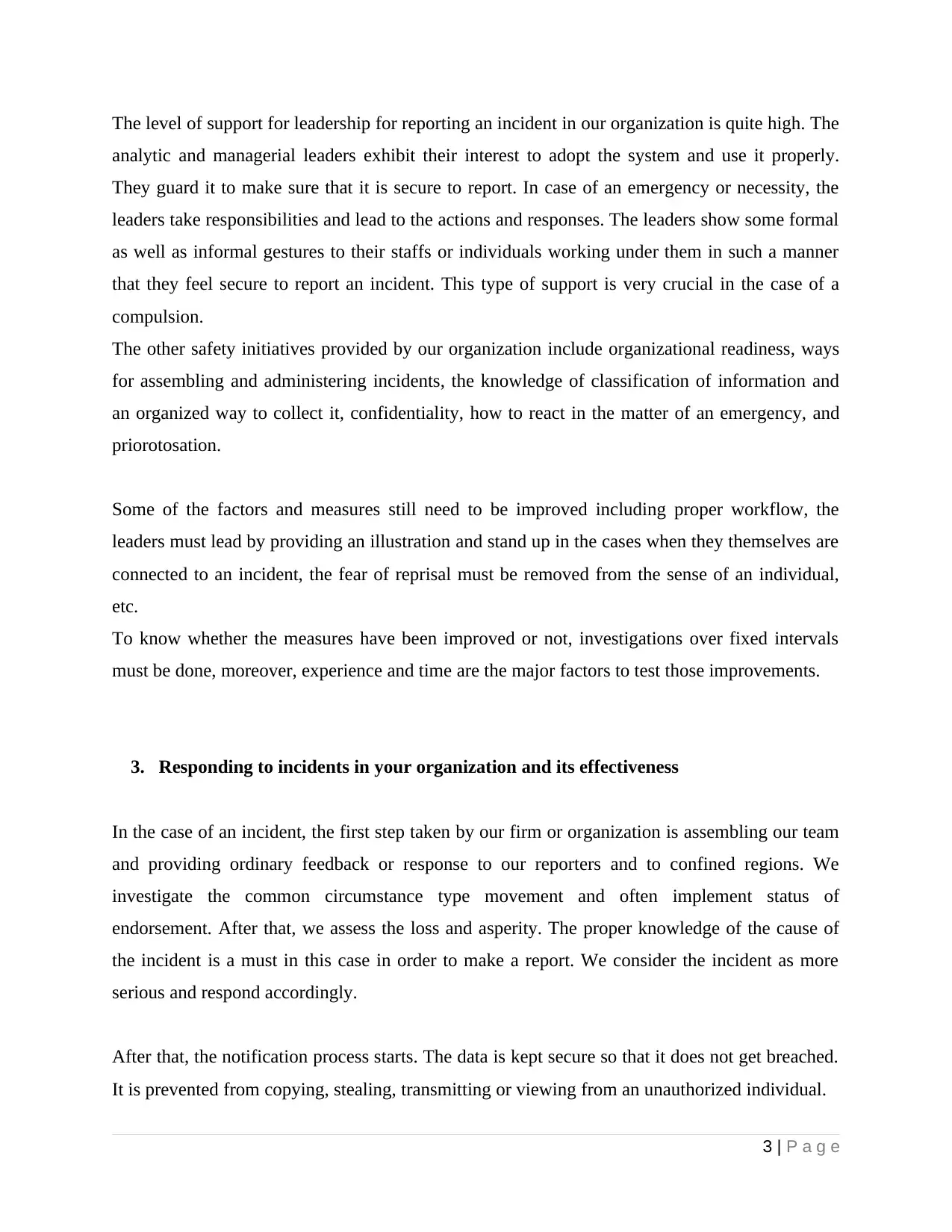
The level of support for leadership for reporting an incident in our organization is quite high. The
analytic and managerial leaders exhibit their interest to adopt the system and use it properly.
They guard it to make sure that it is secure to report. In case of an emergency or necessity, the
leaders take responsibilities and lead to the actions and responses. The leaders show some formal
as well as informal gestures to their staffs or individuals working under them in such a manner
that they feel secure to report an incident. This type of support is very crucial in the case of a
compulsion.
The other safety initiatives provided by our organization include organizational readiness, ways
for assembling and administering incidents, the knowledge of classification of information and
an organized way to collect it, confidentiality, how to react in the matter of an emergency, and
priorotosation.
Some of the factors and measures still need to be improved including proper workflow, the
leaders must lead by providing an illustration and stand up in the cases when they themselves are
connected to an incident, the fear of reprisal must be removed from the sense of an individual,
etc.
To know whether the measures have been improved or not, investigations over fixed intervals
must be done, moreover, experience and time are the major factors to test those improvements.
3. Responding to incidents in your organization and its effectiveness
In the case of an incident, the first step taken by our firm or organization is assembling our team
and providing ordinary feedback or response to our reporters and to confined regions. We
investigate the common circumstance type movement and often implement status of
endorsement. After that, we assess the loss and asperity. The proper knowledge of the cause of
the incident is a must in this case in order to make a report. We consider the incident as more
serious and respond accordingly.
After that, the notification process starts. The data is kept secure so that it does not get breached.
It is prevented from copying, stealing, transmitting or viewing from an unauthorized individual.
3 | P a g e
analytic and managerial leaders exhibit their interest to adopt the system and use it properly.
They guard it to make sure that it is secure to report. In case of an emergency or necessity, the
leaders take responsibilities and lead to the actions and responses. The leaders show some formal
as well as informal gestures to their staffs or individuals working under them in such a manner
that they feel secure to report an incident. This type of support is very crucial in the case of a
compulsion.
The other safety initiatives provided by our organization include organizational readiness, ways
for assembling and administering incidents, the knowledge of classification of information and
an organized way to collect it, confidentiality, how to react in the matter of an emergency, and
priorotosation.
Some of the factors and measures still need to be improved including proper workflow, the
leaders must lead by providing an illustration and stand up in the cases when they themselves are
connected to an incident, the fear of reprisal must be removed from the sense of an individual,
etc.
To know whether the measures have been improved or not, investigations over fixed intervals
must be done, moreover, experience and time are the major factors to test those improvements.
3. Responding to incidents in your organization and its effectiveness
In the case of an incident, the first step taken by our firm or organization is assembling our team
and providing ordinary feedback or response to our reporters and to confined regions. We
investigate the common circumstance type movement and often implement status of
endorsement. After that, we assess the loss and asperity. The proper knowledge of the cause of
the incident is a must in this case in order to make a report. We consider the incident as more
serious and respond accordingly.
After that, the notification process starts. The data is kept secure so that it does not get breached.
It is prevented from copying, stealing, transmitting or viewing from an unauthorized individual.
3 | P a g e
⊘ This is a preview!⊘
Do you want full access?
Subscribe today to unlock all pages.

Trusted by 1+ million students worldwide
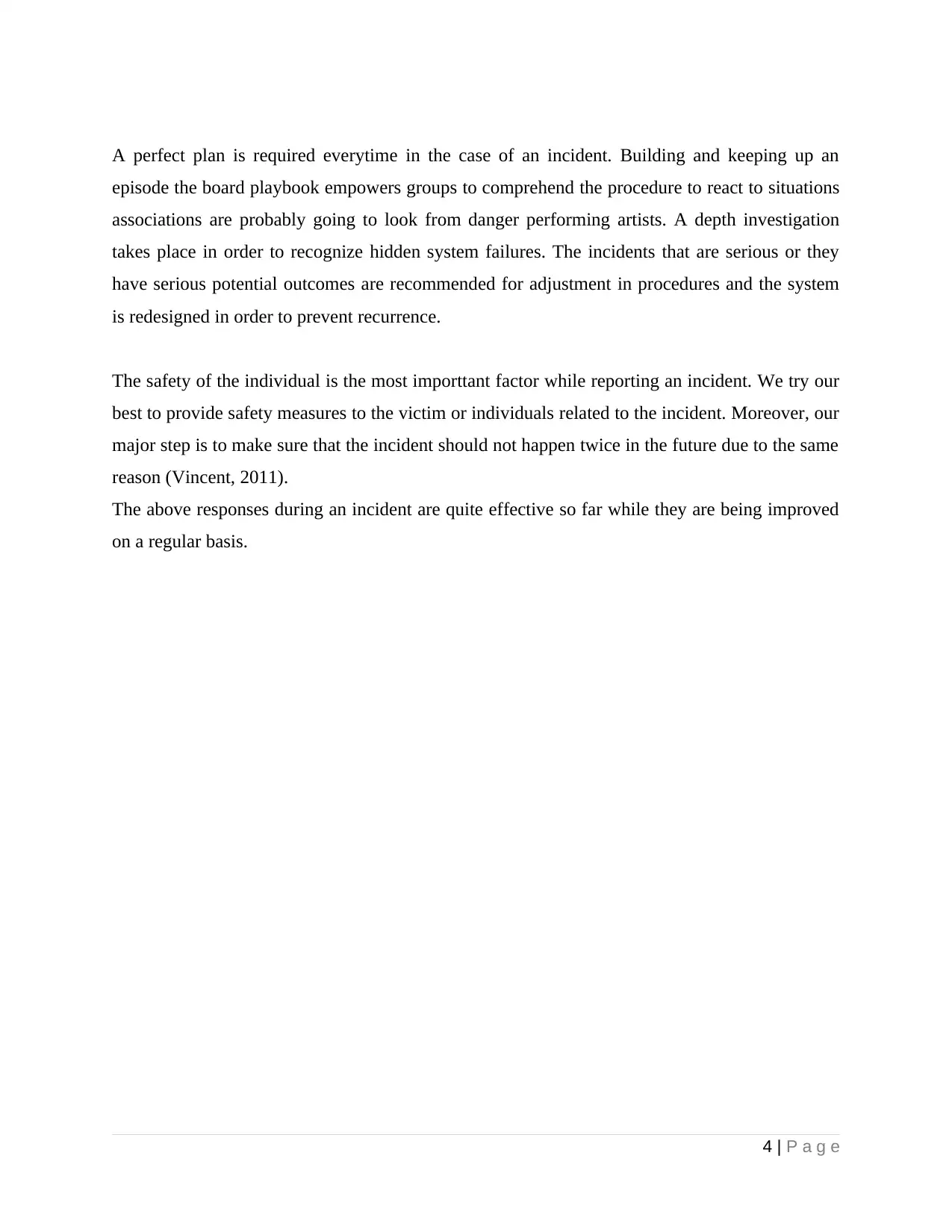
A perfect plan is required everytime in the case of an incident. Building and keeping up an
episode the board playbook empowers groups to comprehend the procedure to react to situations
associations are probably going to look from danger performing artists. A depth investigation
takes place in order to recognize hidden system failures. The incidents that are serious or they
have serious potential outcomes are recommended for adjustment in procedures and the system
is redesigned in order to prevent recurrence.
The safety of the individual is the most importtant factor while reporting an incident. We try our
best to provide safety measures to the victim or individuals related to the incident. Moreover, our
major step is to make sure that the incident should not happen twice in the future due to the same
reason (Vincent, 2011).
The above responses during an incident are quite effective so far while they are being improved
on a regular basis.
4 | P a g e
episode the board playbook empowers groups to comprehend the procedure to react to situations
associations are probably going to look from danger performing artists. A depth investigation
takes place in order to recognize hidden system failures. The incidents that are serious or they
have serious potential outcomes are recommended for adjustment in procedures and the system
is redesigned in order to prevent recurrence.
The safety of the individual is the most importtant factor while reporting an incident. We try our
best to provide safety measures to the victim or individuals related to the incident. Moreover, our
major step is to make sure that the incident should not happen twice in the future due to the same
reason (Vincent, 2011).
The above responses during an incident are quite effective so far while they are being improved
on a regular basis.
4 | P a g e
Paraphrase This Document
Need a fresh take? Get an instant paraphrase of this document with our AI Paraphraser
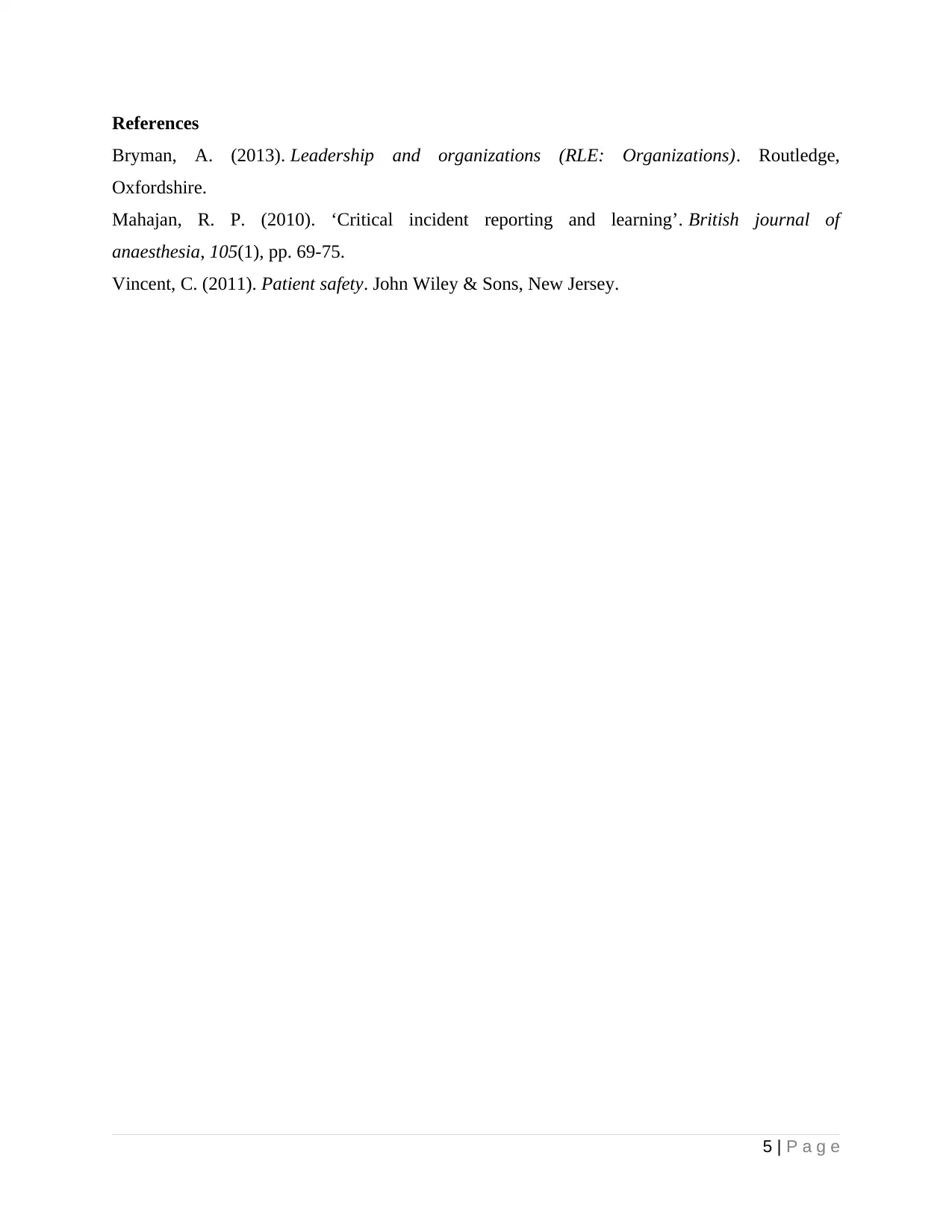
References
Bryman, A. (2013). Leadership and organizations (RLE: Organizations). Routledge,
Oxfordshire.
Mahajan, R. P. (2010). ‘Critical incident reporting and learning’. British journal of
anaesthesia, 105(1), pp. 69-75.
Vincent, C. (2011). Patient safety. John Wiley & Sons, New Jersey.
5 | P a g e
Bryman, A. (2013). Leadership and organizations (RLE: Organizations). Routledge,
Oxfordshire.
Mahajan, R. P. (2010). ‘Critical incident reporting and learning’. British journal of
anaesthesia, 105(1), pp. 69-75.
Vincent, C. (2011). Patient safety. John Wiley & Sons, New Jersey.
5 | P a g e
1 out of 5
Related Documents
Your All-in-One AI-Powered Toolkit for Academic Success.
+13062052269
info@desklib.com
Available 24*7 on WhatsApp / Email
![[object Object]](/_next/static/media/star-bottom.7253800d.svg)
Unlock your academic potential
Copyright © 2020–2025 A2Z Services. All Rights Reserved. Developed and managed by ZUCOL.





